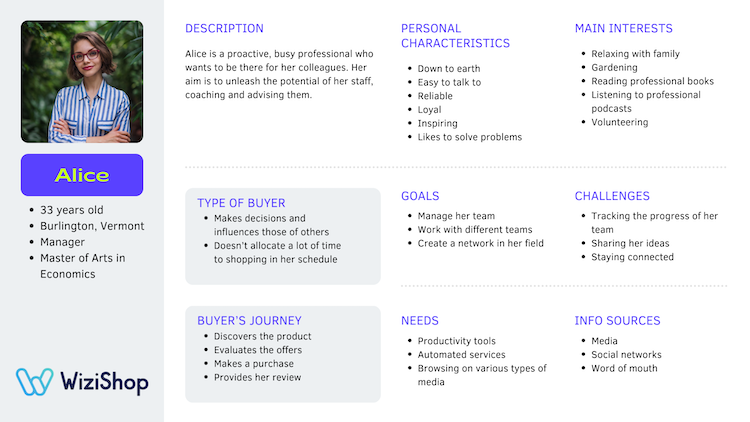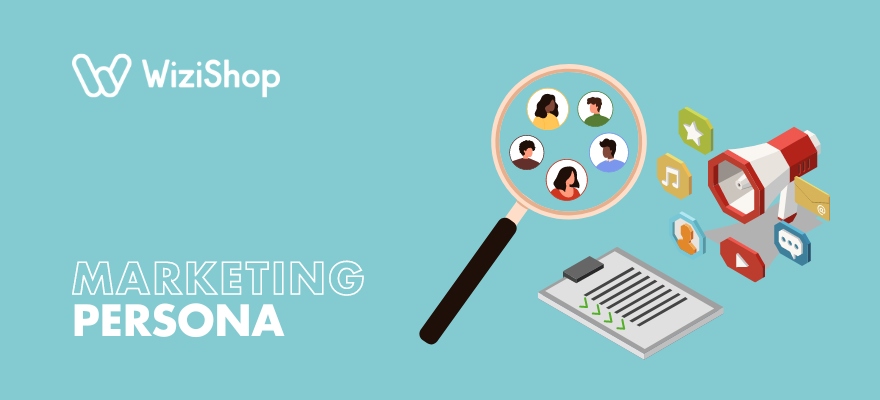In the early days of marketing, advertising messages were sent out en masse, without any really precise targeting. However, brands soon realized that potential customers were being inundated with promotional messages, not always tailored to their needs.
This is how inbound marketing came about. The aim? Position yourself as an expert in your field and deliver the right information to potential customers, to capture their attention and win them over. For this strategy to be successful, however, it's essential that you know your target audience inside out, hence the importance of this first step of defining your marketing persona.
In marketing, the persona, also known as the buyer persona, is a central element. It's a group of people who share the same problem in relation to an offer. In other words, it's your core target.
Thanks to the precise profiles of the target audience and the personas defined ahead of time by the company, marketing goals can be reached more quickly and easily. How do you define your buyer persona profile with the utmost precision to ensure that you're doing your best to reach your prospects and increase online sales? How do you create a persona template complete with all the necessary information?
Keep reading to learn the answers to these questions and more!
Marketing personas: Definition and benefits
In digital product marketing or that involving physical goods or a service, the target customer or persona is the backbone of any online business. Let's take an in-depth look at the importance of building a precise profile of your buyer persona.
What is a buyer or customer persona in marketing?
Marketing personas are fictitious representations of the ideal type of customer for your company. Defining your buyer persona is, in a way, like drawing up a portrait of the perfect customer. To do this, you first need to conduct research or interviews. A long quest for qualitative and quantitative information begins...
Defining your ecommerce persona involves much more than gathering demographic information about your customers. The characteristics of these portraits are much more detailed. Their favorite product, their buying habits, the services they appreciate on the web... It's more a question of comprehending your target customers' major buying motivations, as well as their objectives, behaviors, pain points, and concerns... You need to have a good understanding of the precise definition of profiles in relation to your business goals!
What are negative personas?
In addition to buyer personas, you might also have heard of negative personas. Negative personas in marketing refer to semi-fictional representations of the types of customers a business does not want to attract. These are essentially the opposite of the ideal customer profiles (or positive personas) that marketing efforts are typically designed to appeal to.
Negative personas help marketers and businesses identify individuals who are not a good fit for their products or services, either because they do not have the right characteristics, would not find value in the offering, or could cost more to acquire than they would return in value.
By understanding these negative personas, brands can more efficiently allocate their marketing resources, avoid ineffective targeting, and focus on prospects that are more likely to convert into valuable customers.
What are the advantages of a well-defined persona profile?
Creating a persona is essential before launching any inbound marketing campaign. In fact, this applies to all types of business structures, regardless of the size of your company. If you don't know your customers precisely, it's impossible to offer them sufficiently effective marketing content.
Without a good persona, you won't be able to generate qualified leads or pique enough interest to push them to buy and gain customers online. Creating a persona is THE starting point for a successful sale! It makes everything easier, from the design of your website to the content of your company blog, newsletters, lead magnets, and landing pages!
Obtaining pertinent knowledge concerning the people in your target audience and precisely defining a buyer persona offers numerous benefits in that it can help you to do the following:
- build a more solid customer database,
- adapt your offer to your core market and target segments,
- anticipate future customer needs, and
- stand out from the competition.
Because digital marketing for brands has evolved so much, it's simply unthinkable to create content haphazardly. It's like fishing without bait... don't even expect it to bite! If you want your ecommerce marketing campaigns to deliver consistently positive results, you absolutely must take the time to establish a high-quality strategy.
How do you build a buyer persona? 5 Key characteristics
Setting up a persona in marketing is like drawing up a kind of customer identity card. It can help if you start by breaking it down into five main headings.
Age and gender of the typical customer
In order to understand your customer's expectations, it's essential to know your buyer persona's average age. The language and needs of your persona will vary according to the generation to which your ideal customer belongs. Likewise, women and men are often not going to be addressed in the same way.
Job and socio-professional category
Education is another key element in the portrait of a buyer persona. In addition, it's essential to know your target customer's current status and position. Are they a student, employed, retired, or looking for work? This also means knowing their average annual income, as this can give you a good idea of their spending budget for buying products like yours.
Personality details
It's also important to identify other aspects of your ideal buyer's personality by determining answers to the following questions:
- What are their habits and lifestyle?
- What is their family situation?
- What are their communication preferences?
- How do they communicate?
- What language do they speak?
- How much time do they spend online each day?
- What is their typical browsing pattern?
- On which platforms are they present?
Interests and passions
While we're on the subject of your buyer persona's personality, it's clear that their interests and passions are central to any marketing strategy. Logically, customers are more likely to be interested in sectors in which they have an interest. Find out what motivates your customers, or in contrast, what bores them...
In some parts of the world, certain hobbies are more popular, and certain character traits may be more dominant.
Friction points and ecommerce requirements
Finally, make sure to identify the elements that your persona seeks to fill, what their market expectations are, and what specific challenges or pain points they encounter on a daily basis. This may enable you to objectively highlight any potential misgivings about your company.
Ask them about their background and history... Is this their first buying experience? Have they dealt with a company similar to yours in the past? What is their preferred buying path on similar sites? What are their expectations and potential disincentives? Are they the only decision-maker in the purchasing act? What is their spending budget? Etc. In short, what are all the elements likely to influence the way they consume?
How do you create a buyer persona? Creation tools
As you will have gathered by now, creating your brand's buyer persona is a long and complex process. To do this, you will need to gather as much information as possible concerning your prospects. It's up to you to do it yourself, or, depending on your budget, you can enlist the help of others to obtain this knowledge.
Create your own persona chart in table form
If you decide to create your persona chart yourself and compile all the data collected in the form of a table, you will need to draw on different sources of information. To analyze your target customer, your market, and your competition, you have several options:
- Call on your teams for ideas: Who better to talk to you about your customers and prospects than your staff, your marketing director, or your sales team? Start by asking your sales team, your marketing staff, or your after-sales service.
- Rely on analytics tools: Leverage analytics tools like Google Analytics, social media insights, or customer relationship management (CRM) software to analyze customer behavior and preferences. Look for trends in how different segments of your audience interact with your content or website. Think about researching the most frequently recurring keywords around your theme. See which searches are the most popular.
- Perform a competitor analysis: While not directly involving your customers, analyzing your competitors and their customer feedback can offer insights into what might resonate with your own audience. Look for patterns in reviews and social media comments on your competitors' channels.
- Visit forums and check out white papers: These sites offer a wealth of information, enabling you to learn a great deal about your potential customers through exchanges between Internet users. You will easily spot the major trends of the moment, as well as the issues common to most of your buyers. For the same reasons, don't hesitate to visit groups related to your products on social networks, or to read market studies related to your sector of activity.
- Send surveys and questionnaires to your customers: Design surveys that are concise and targeted, with questions that help you understand the customer's demographics, preferences, behaviors, and pain points. Utilize tools like Google Forms or SurveyMonkey to distribute these surveys through email, social media, or as a pop-up on your website.
- Interview your customers: Conduct one-on-one interviews with a diverse group of customers to gain deeper insights into their motivations, challenges, and experiences with your product or service. These interviews can be done in person, over the phone, or via video conferencing platforms.
- Engage with people on social media: Use social media platforms to engage with your audience. Ask questions, create polls, and start discussions to gather opinions and feedback. Monitor comments and direct messages to understand the common questions or concerns among your audience.
- Avail of customer feedback forms: Implement feedback forms on your website or after purchase/service completion. Encourage customers to provide feedback about their experience, which can be invaluable in understanding their needs and expectations.
- Try user experience (UX) testing: Invite customers to participate in UX testing for your website or product. Observing how they interact with your offering can provide insights into potential improvements and the aspects they find most valuable.
- Incentivize participation: Encourage more customers to participate in your research by offering incentives such as discounts, freebies, or entry into a contest. Make sure the incentive is relevant and valuable to your audience.
- Remember follow-up communications: After an initial purchase or interaction, follow up with customers via email or direct message to ask about their experience and any feedback they might have. This is a great way to not only provide you with valuable information but also shos customers that you value their input.
Use a specialized marketing agency
It's a fact: setting up your buyer personas is a long and tedious job. However, it's a crucial step that shouldn't be taken lightly. Today, inbound marketing is even considered to be the digital strategy offering the best return on investment. But it's all about understanding your target audience!
The reason this profile is so important is that it's the fundamental element in determining how you'll work and how you'll communicate your brand. It'll be one of the foundations of your corporate culture.
That being said, you can't become a persona expert overnight. Perhaps you don't feel ready to undertake such a project. In that case, it's a task you can delegate entirely to a marketing agency.
Because the future of your company depends on it, don't hesitate to call on an outside firm to help you implement your digital strategy. Of course, there will be a cost involved.
However, the benefits of outsourcing these tasks can be numerous. It often improves the performance of marketing campaigns and sales efficiency. It can also have a significant impact on support teams...
Use an online persona generator
Finally, there's also a 100% online solution to help you create your own persona template: https://www.hubspot.com/make-my-persona. This free tool is based on a 7-step questionnaire:
- Create an avatar: this humanizes the persona by giving it a face and a name, so that it can be seen as a real person.
- Add demographic data: age range, highest level of education.
- Select company information: business sector and number of employees.
- Provide career details: job title, performance, presence or absence of a supervisor.
- Supply other job-related details: objectives, greatest challenges, responsibilities.
- Add information about the way your buyer persona works: the tools they use on a daily basis, their preferred means of communication.
- Information sources: such as favorite social networks or blog posts.
Based on the data provided, the software completes a clear, highly visual template, which can then be saved and/or downloaded. The template can also be customized and sections added to achieve a specific goal. This is an excellent starting point for establishing a marketing strategy, while keeping in mind your persona's list of characteristics, which are essential for good communication with them.

Example of a persona template
Keep in mind that your persona is a fictional character who is constantly evolving, especially as he or she moves through the various stages of the buying process. Over time, new needs may emerge. So your ecommerce content marketing strategy needs to adapt gradually, as your persona, or different personas, evolve.
Don't forget to evolve your customer's profile and template according to the way they buy and consume. Always remain attentive to possible changes and potential questions, and prepare your answers as best you can. Better still: if possible, anticipate them so you can adapt the right message at the right time!
Target the right consumers by defining your persona
Defining your marketing persona and taking the time to create a well-crafted template for your persona or personas are critical steps in crafting a marketing strategy that resonates deeply with your target audience. By obtaining helpful knowledge about your target market and understanding the demographic, psychographic, and behavioral traits of your ideal customer, you can create relevant content and marketing messages that focus on personalization and that are more effective.
Remember, the key to the development of a successful marketing persona is thorough research, continuous refinement, and empathy. As your market evolves, so should your personas. Staying attuned to the needs and preferences of the people in your target audience offers many benefits, specifically allowing you to ensure that your marketing efforts are always on target, driving engagement, loyalty, and ultimately, business success.










